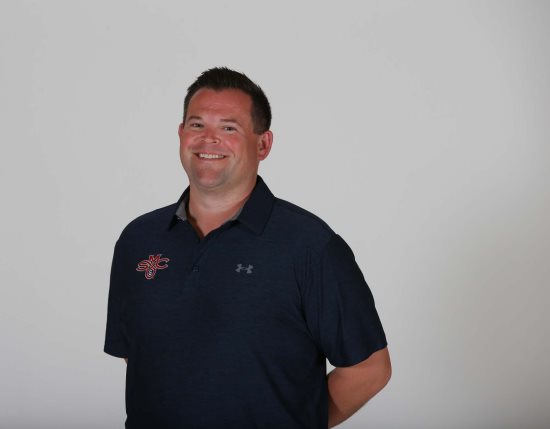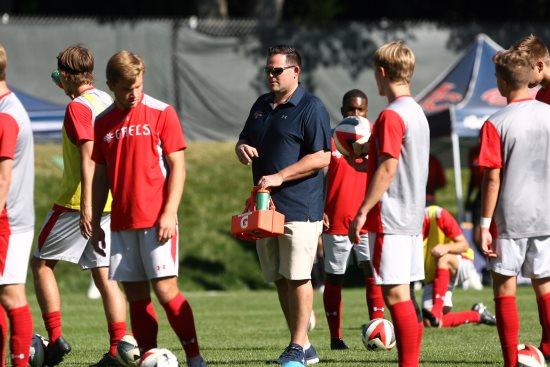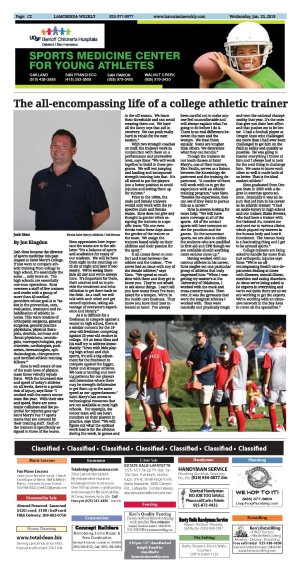| | Published January 23rd, 2019
| The all-encompassing life of a college athletic trainer
| | | By Jon Kingdon |  | | Josh Sims Photos Saint Mary's Athletics / Tod Fierner |
Josh Sims became the director of sports medicine this past August at Saint Mary's College. If you were to compare athletic training from college to high school, it's essentially the same . only more so. The high schools are essentially one-man operations. Sims oversees a staff of five trainers and works with a group of more than 40 medical providers whose goal is to "assist in the prevention, care, evaluation, treatment and rehabilitation of athletic injuries. This team consists of orthopedic surgeons, general surgeons, general practice physicians, physical therapists, dentists, ear/nose and throat physicians, neurologists, nueropsychologists, psychiatrists, cardiologists, podiatrists, dermatologists, ophthalmologists, chiropractors and certified athletic training fellows."
 Sims is well aware of one of the main laws of physics: mass times velocity equals force. With the increased size and speed of today's athletes on all levels, there is a greater risk of injury, says Sims: "I worked with the men's soccer team this year. With their size and speed, there are some major collisions and the potential for injuries goes up."
Sims is well aware of one of the main laws of physics: mass times velocity equals force. With the increased size and speed of today's athletes on all levels, there is a greater risk of injury, says Sims: "I worked with the men's soccer team this year. With their size and speed, there are some major collisions and the potential for injuries goes up."
 Saint Mary's has 17 sports teams that are covered by their training staff. Each of the trainers is specifically assigned to three of the teams. Sims appreciates how important the teams are to the athletes: "It's a balance of sports and academics for many of our students. We will be here from eight in the morning until six at night and later if necessary. We're seeing these kids all day and we're always here. It's important for them, their coaches and us to provide the treatment and rehabilitation to get them back on the field. As a staff, we will talk with each other and get second opinions, taking advantage of everyone's experience and history."
Saint Mary's has 17 sports teams that are covered by their training staff. Each of the trainers is specifically assigned to three of the teams. Sims appreciates how important the teams are to the athletes: "It's a balance of sports and academics for many of our students. We will be here from eight in the morning until six at night and later if necessary. We're seeing these kids all day and we're always here. It's important for them, their coaches and us to provide the treatment and rehabilitation to get them back on the field. As a staff, we will talk with each other and get second opinions, taking advantage of everyone's experience and history."
 As it is difficult for a freshman to compete against a senior in high school, there is a similar concern for the 18-year-old freshmen competing against 22-year-old seniors in college. It's an issue Sims and his staff try to address immediately: "Even with kids playing high school and club sports, it's still a big adjustment for the freshmen to compete against the bigger, faster and stronger athletes. We look at landing and moving patterns for our players and determine where there may be strength deficiencies to get them up to the same speed as our upperclassmen."
As it is difficult for a freshman to compete against a senior in high school, there is a similar concern for the 18-year-old freshmen competing against 22-year-old seniors in college. It's an issue Sims and his staff try to address immediately: "Even with kids playing high school and club sports, it's still a big adjustment for the freshmen to compete against the bigger, faster and stronger athletes. We look at landing and moving patterns for our players and determine where there may be strength deficiencies to get them up to the same speed as our upperclassmen."
 Saint Mary's has access to technological resources that are not available at most high schools. For example, the soccer team will use heart monitors on their players in practice, says Sims: "We will figure out what the optimal work load is for the athletes during the week, in games and in the off season. We learn their thresholds and can avoid wearing them out. We have all the fancy toys that aid in recovery. We can push really hard in rehab for the next session."
Saint Mary's has access to technological resources that are not available at most high schools. For example, the soccer team will use heart monitors on their players in practice, says Sims: "We will figure out what the optimal work load is for the athletes during the week, in games and in the off season. We learn their thresholds and can avoid wearing them out. We have all the fancy toys that aid in recovery. We can push really hard in rehab for the next session."
 With two strength coaches on staff, the trainers work in conjunction with them on a performance and preventive level, says Sims: "We will work together to build in these programs. We will test jumping and landing and incorporate strength training into that. It's all aimed to put the players into a better position to avoid injuries and setting them up for success."
With two strength coaches on staff, the trainers work in conjunction with them on a performance and preventive level, says Sims: "We will work together to build in these programs. We will test jumping and landing and incorporate strength training into that. It's all aimed to put the players into a better position to avoid injuries and setting them up for success."
 Prior to the 1980s, the male and female trainers would only work with the respective male and female teams. Sims does not give any thought to gender when assigning the trainers to a specific team: "No one even thinks twice these days about the gender of the trainer or the team. We assign the trainers based solely on their abilities and their passion for the sport."
Prior to the 1980s, the male and female trainers would only work with the respective male and female teams. Sims does not give any thought to gender when assigning the trainers to a specific team: "No one even thinks twice these days about the gender of the trainer or the team. We assign the trainers based solely on their abilities and their passion for the sport."
 It all comes down to comfort and trust between the athlete and the trainer. "I've never had an issue with any of the female athletes," says Sims. "We spend so much time with them and they get to know you. They're not afraid to ask about things. I can't tell you how many times I've been asked for a tampon. We're in the health care business. They know you have their best interests at heart. I've always been careful not to make anyone feel uncomfortable and will always explain what I'm going to do before I do it. There is no real difference between the men and the women. We treat them equally. Some are tougher than others. We determine what they can handle."
It all comes down to comfort and trust between the athlete and the trainer. "I've never had an issue with any of the female athletes," says Sims. "We spend so much time with them and they get to know you. They're not afraid to ask about things. I can't tell you how many times I've been asked for a tampon. We're in the health care business. They know you have their best interests at heart. I've always been careful not to make anyone feel uncomfortable and will always explain what I'm going to do before I do it. There is no real difference between the men and the women. We treat them equally. Some are tougher than others. We determine what they can handle."
 Though the trainers do not teach classes at Saint Mary's, one of their trainers, Kira Paulin, serves as a liaison between the kinesiology department and the training department. "A number of them will work with us to get the experience with an athletic training program," says Sims. "Besides the experience, they can see if they want to pursue this as a career."
Though the trainers do not teach classes at Saint Mary's, one of their trainers, Kira Paulin, serves as a liaison between the kinesiology department and the training department. "A number of them will work with us to get the experience with an athletic training program," says Sims. "Besides the experience, they can see if they want to pursue this as a career."
 Sims is always looking for more help: "We will have some coverage at all of the sports. All of the contact sports will have someone on site for practices and the games. On the noncontact sports, we are able to utilize the students who are qualified in first aid and CPR though we are available should anything more serious come up."
Sims is always looking for more help: "We will have some coverage at all of the sports. All of the contact sports will have someone on site for practices and the games. On the noncontact sports, we are able to utilize the students who are qualified in first aid and CPR though we are available should anything more serious come up."
 Having worked with numerous athletes in his career, Sims singles out one particular group of athletes that truly impressed him: "When I was getting my master's at the University of Oklahoma, I worked with the track and cross-country teams. However, it was the gymnasts that were the toughest athletes I worked with. They were mentally and physically tough and won the national championship that year. It's the ones that give you their best effort and that pushes me to be better. I had a football player at Oregon State who challenged me more than I had ever been challenged to get him on the field as safely and quickly as possible. He was going to master everything I threw at him and I always had to look for the next thing to challenge him. We came to know each other so well it made both of us better. That is the ideal student-athlete."
Having worked with numerous athletes in his career, Sims singles out one particular group of athletes that truly impressed him: "When I was getting my master's at the University of Oklahoma, I worked with the track and cross-country teams. However, it was the gymnasts that were the toughest athletes I worked with. They were mentally and physically tough and won the national championship that year. It's the ones that give you their best effort and that pushes me to be better. I had a football player at Oregon State who challenged me more than I had ever been challenged to get him on the field as safely and quickly as possible. He was going to master everything I threw at him and I always had to look for the next thing to challenge him. We came to know each other so well it made both of us better. That is the ideal student-athlete."
 Sims graduated from Oregon State in 2005 with a degree in exercise sports science. Ironically it was an injury that led him to his career as an athletic trainer: "I had an ankle injury in high school and our trainer, Blake Bowers, who had been a trainer with the Oakland A's, treated me and sent me to various clinics which piqued my interest in the human body and how it functioned. The human body is a fascinating thing and I get to be around sports."
Sims graduated from Oregon State in 2005 with a degree in exercise sports science. Ironically it was an injury that led him to his career as an athletic trainer: "I had an ankle injury in high school and our trainer, Blake Bowers, who had been a trainer with the Oakland A's, treated me and sent me to various clinics which piqued my interest in the human body and how it functioned. The human body is a fascinating thing and I get to be around sports."
 College trainers are being asked to handle far more than just orthopedic injuries says Sims: "We're an all-encompassing health care department dealing at times with illnesses, mental illness, nutrition and eating disorders. At times we're being asked to be experts in everything and we're not quite there yet so we are working to get the experts. We're working with an extensive network in the Bay Area to cover all the specialties."
College trainers are being asked to handle far more than just orthopedic injuries says Sims: "We're an all-encompassing health care department dealing at times with illnesses, mental illness, nutrition and eating disorders. At times we're being asked to be experts in everything and we're not quite there yet so we are working to get the experts. We're working with an extensive network in the Bay Area to cover all the specialties." |
 | | | | | | | | | | | | | |




